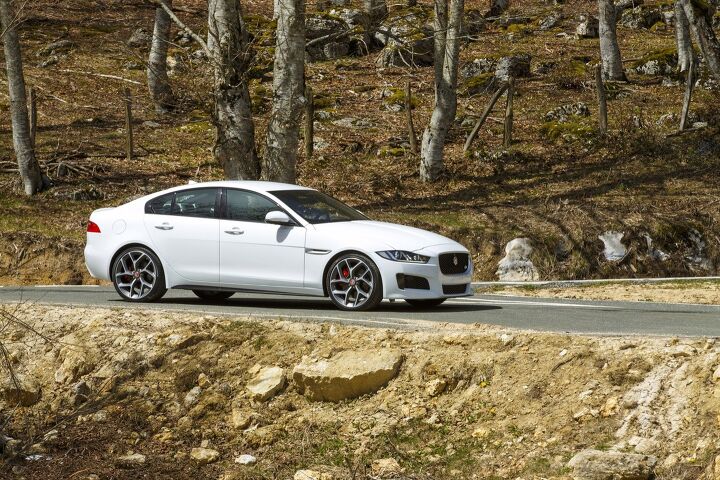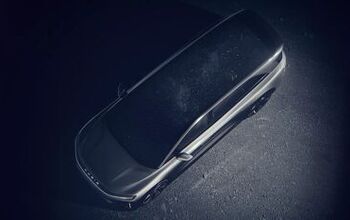Jaguar Doesn't Want To Get Too Popular
Jaguar’s U.S. volume more than doubled in 2016, rising to a 12-year high thanks to the launch of an all-new entry-level sedan and the brand’s first-ever SUV.
The XE and F-Pace, which now account for nearly three-quarters of Jaguar’s U.S. volume, have taken the brand to a high-volume place (relatively speaking) Jaguar hasn’t visited since the X-Type roamed dealer forecourts.
One year ago, those models didn’t exist, and Jaguar was selling fewer than 50 cars per day in America.
Now Jaguar’s on fire. Year-over-year growth is explosive, with Jaguar’s U.S. volume more than doubling in each of the last ten months and more than tripling in each of 2016’s final three months.
That level of growth can’t be sustained. Jaguar Land Rover North America’s CEO Joachim Eberhardt told Wards Auto, “We have to continue to grow, but we are not looking to grow at the pace we have been.”
All that growth “still does not make us a giant luxury brand,” Eberhardt says. “It makes us a bigger luxury brand that now has scale but is still special and exclusive.”
There’s the key word. Exclusive. “I think that is part of our appeal and something to focus on maintaining,” claims Eberhardt.
What a revolutionary approach for a premium auto brand.
Of course, Jaguar isn’t the only portion of Tata’s Jaguar Land Rover machine. Jaguar, in fact, is the smaller cog. And growth at Land Rover has been significant, as well. Though Land Rover sales are actually down slightly through the first two months of 2017, calendar year 2016 was the brand’s best U.S. sales year ever, with volume across the brand doubling between 2011 and 2016.
Powered by a massive lineup expansion that isn’t yet complete — the Range Rover Velar is up next — Land Rover is entirely present in the heart of the luxury market’s growth sector: SUVs. Land Rover doesn’t sell a single passenger car.
Jaguar, on the other hand, required an SUV to shed its cars-only status. And by launching the F-Pace, Jaguar ended up producing 30 percent of JLR’s U.S. volume in 2016, nearly double its 17 percent share one year earlier. Through early 2017, 35 percent of JLR’s U.S. sales are Jaguar-derived.
But we’ve yet to see whether Jaguar can further its charge into a U.S. luxury market dominated by Mercedes-Benz, Lexus, and BMW, brands which are capable of selling more vehicles in a single month than Jaguar did all of last year. Comparisons that will show whether the full Jaguar lineup — F-Pace, XE, XF, XJ, F-Type — can grow relative to the volume achieved by the full five-pronged Jaguar lineup in the year-ago period won’t occur for another two months.
Based on Eberhardt’s language, however, it appears as though Jaguar’s expectations are not lofty. Although Jaguar sold more than 50,000 vehicles in America as recently as 2003, 40,000-45,000 sales seems like a more realistic target for 2017. And if that’s alright with Jaguar, it ought to be alright with us, too.
Luxury shouldn’t have to equal popularity. The Mercedes-Benz C-Classes and Lexus RXs and BMW 3 Series sedans grazing every level of every parking garage do a fine job of showcasing to the world the upmarket image of Mercedes-Benz, Lexus, and BMW, but they certainly don’t represent exclusivity.
The fact Jaguars aren’t seen everywhere, that exclusivity “sets us apart from the others,” Jaguar’s Eberhardt says.
Meanwhile, setting the Jaguar of today apart from the Jaguar of yesterday is the prevalence of diesel engines. 13 percent of the Jaguars sold in the United States through the first two months of 2017 were diesel-powered: 611 diesel F-Paces, 142 diesel XEs, and 62 diesel XFs.
Want exclusivity, a car you’re certain will not appear in your neighbor’s driveway? A diesel-engined midsize Jaguar sedan should do the trick.
Timothy Cain is the founder of GoodCarBadCar.net, which obsesses over the free and frequent publication of U.S. and Canadian auto sales figures. Follow on Twitter @goodcarbadcar and on Facebook.
More by Timothy Cain
Latest Car Reviews
Read moreLatest Product Reviews
Read moreRecent Comments
- Formula m How many Hyundai and Kia’s do not have the original engine block it left the factory with 10yrs prior?
- 1995 SC I will say that year 29 has been a little spendy on my car (Motor Mounts, Injectors and a Supercharger Service since it had to come off for the injectors, ABS Pump and the tool to cycle the valves to bleed the system, Front Calipers, rear pinion seal, transmission service with a new pan that has a drain, a gaggle of capacitors to fix the ride control module and a replacement amplifier for the stereo. Still needs an exhaust manifold gasket. The front end got serviced in year 28. On the plus side blank cassettes are increasingly easy to find so I have a solid collection of 90 minute playlists.
- MaintenanceCosts My own experiences with, well, maintenance costs:Chevy Bolt, ownership from new to 4.5 years, ~$400*Toyota Highlander Hybrid, ownership from 3.5 to 8 years, ~$2400BMW 335i Convertible, ownership from 11.5 to 13 years, ~$1200Acura Legend, ownership from 20 to 29 years, ~$11,500***Includes a new 12V battery and a set of wiper blades. In fairness, bigger bills for coolant and tire replacement are coming in year 5.**Includes replacement of all rubber parts, rebuild of entire suspension and steering system, and conversion of car to OEM 16" wheel set, among other things
- Jeff Tesla should not be allowed to call its system Full Self-Driving. Very dangerous and misleading.
- Slavuta America, the evil totalitarian police state



































Comments
Join the conversation
Exclusivity is a good way to explain away why they only move a handful of units each month. Its very hipstery. "My XF is worth $2000 more than your sane year, same mileage LaCrosse because people just don't understand"
Don't sweat it Jaguar, sales will slow plenty when these things start coming back to the dealer with the usual Jaguar problems and word gets out.